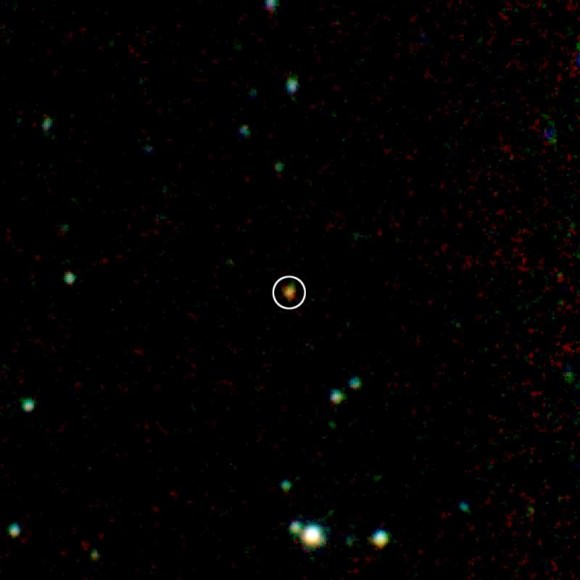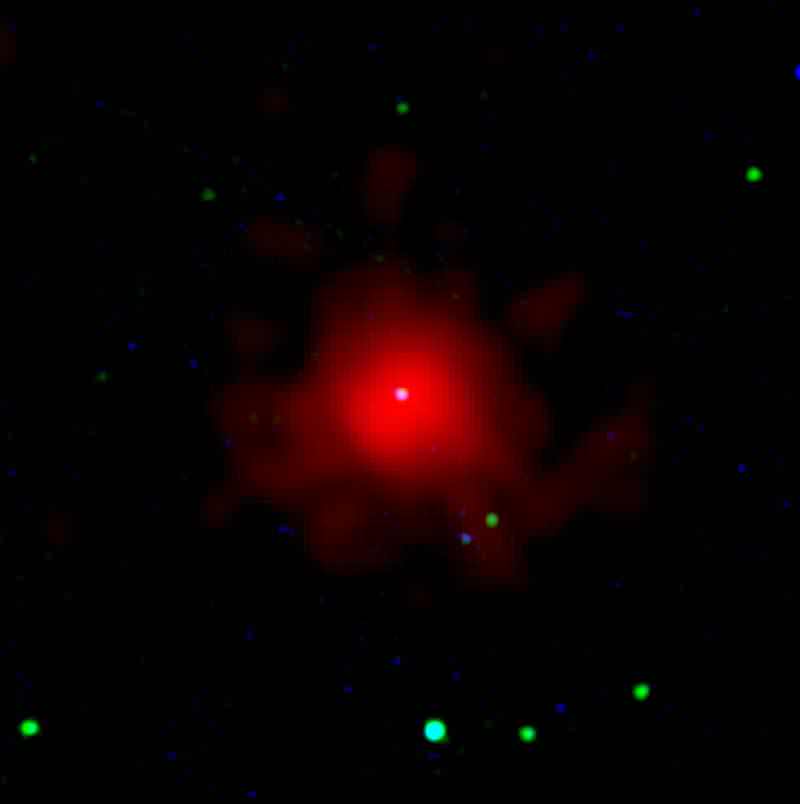[/caption]
Gamma-ray bursts are the universe’s most brilliant events, and now astronomers have been able to shed light on the composition of these spectacular phenomena, providing insight into star formation when the universe was about one-sixth its present age. Combining data from NASA’s Swift satellite, the W. M. Keck Observatory in Hawaii, and other facilities astronomers have, for the first time, identified gas molecules in the host galaxy of a gamma-ray burst. “We clearly see absorption from two molecular gases: hydrogen and carbon monoxide. Those are gases we associate with star-forming regions in our own galaxy,” said Xavier Prochaska, from the University of California Santa Cruz. He and his team believe that the burst exploded behind a thick molecular cloud similar to those that spawn stars in our galaxy today.
The explosion, designated GRB 080607, occurred in June, 2008. “This burst gave us the opportunity to ‘taste’ the star-forming gas in a young galaxy more than 11 billion light-years away,” said Prochaska.
Gamma rays from GRB 080607 triggered Swift’s Burst Alert Telescope shortly after 2:07 a.m. EDT on June 7, 2008. Swift calculated the burst’s position, beamed the location to a network of observatories, and turned to study the afterglow.
That night, University of California, Berkeley, professor Joshua Bloom and graduate students Daniel Perley and Adam Miller were using the Low Resolution Imaging Spectrometer on the 10m Keck I Telescope in Hawaii. “Because afterglows fade rapidly, we really had to scramble when we received the alert,” Perley says. “But in less than 15 minutes, we were on target and collecting data.”

A pair of robotic observatories also responded quickly. The NASA-supported Peters Automated Infrared Imaging Telescope (PAIRITEL) on Mount Hopkins, Ariz., and the Katzman Automatic Imaging Telescope (KAIT) at Lick Observatory on Mount Hamilton, Calif., observed the burst’s afterglow within three minutes of Swift’s alert.
The spectrum from Keck established that the explosion took place 11.5 billion light-years away. GRB 080607 blew up when the universe was just 2.2 billion years old.
The molecular cloud in the burst’s host galaxy was so dense, less than 1 percent of the afterglow’s light was able to penetrate it. “Intrinsically, this afterglow is the second brightest ever seen. That’s the only reason we were able to observe it at all,” Prochaska says.
Screening from thick molecular clouds provides a natural explanation for so-called “dark bursts,” which lack associated afterglows. “We suspect that previous events like GRB 080607 were just too faint to be observed,” says team member Yaron Sheffer of the University of Toledo, Ohio.
Nearly half of the absorption lines found in the Keck spectrum are unidentified. The team expects that understanding them will provide new data on the simplest space molecules.
Prochaska and Sheffer presented the findings today at the 213th meeting of the American Astronomical Society in Long Beach, Calif. A paper describing the results will appear in a future issue of Astrophysical Journal Letters.
Most gamma-ray bursts occur when massive stars run out of nuclear fuel. As the star’s core collapses into a black hole or neutron star, gas jets punch through the star and into space. Bright afterglows occur as the jets heat gas that was previously shed by the star. Because a massive star lives only a few tens of millions of years, it never drifts far from its natal cloud.
Source: NASA


I thought that GRB’s occurred at the scale of the super massive black hole rather than the stellar scale. The difference is many orders of magnitude.
Can someone set me straight on this?
No one has ever observed a super massive black hole.
“…the ‘Schwarzschild singularities’ do not exist in physical reality.” — Albert Einstein, 1939
2 thoughts
first–all the articles I have read say a grb is from one star going out with a real bang;
second–Albert Einstien was wrong about several things. (gasp!)
# Ayti Says:
January 6th, 2009 at 2:39 pm
“I thought that GRB’s occurred at the scale of the super massive black hole rather than the stellar scale. The difference is many orders of magnitude.
Can someone set me straight on this?”
Hi Ayti – a quick and dirty quote from wikipedia for you, which basically sums up the current paradigm:
“There are at least two different types of progenitors (sources) of GRBs: one responsible for the long-duration, soft-spectrum bursts and one (or possibly more) responsible for short-duration, hard-spectrum bursts. The progenitors of long GRBs are believed to be massive, low-metallicity stars exploding due to the collapse of their cores. The progenitors of short GRBs are still unknown but mergers of neutron stars is probably the most popular model as of 2007.”
It is possible you were thinking about quasars, which are indeed powered by supermassive black holes.
Honestly Oills – why do you bother? What is your deal? What philosophy or idea do you adhere to? Full disclosure would be nice.
The evidence for supermassive black holes is so compelling that it would take nothing short of the biblical apocalypse to overthrow it. I guarantee whatever ‘idea’ you are peddling could not explain the most basic observations that astronomers have made over the years regarding these objects.
And, no the Schwarzchild singularity may not exist – quantum gravity (in whatever form it ends up coming in) will likely overthrow that idea. But the existence of a singularity and the existence of black holes are two separate issues. One has to do with the existence of an object in and of itself, and one has to do with a very specific (and non-critical) property of said object. Black holes can (and probably do) exist without singularities.
Finally – a quote from an authority figure such as Einstein means nothing – he was a brilliant physicist, but still just a man. He got plenty right and plenty wrong in his life. He also worked almost a century ago, when physics was in a very much less advanced state than it is today. Why would he have any clue as to whether an esoteric property of an esoteric object was one way or the other? He may as well have been theorising about trends in computing and information technology – the necessary groundwork was not in place for him to make an informed decision at the time, even though it may have appeared to be to him as though it was.
P.S – NANCY – you’re doing a great job at pumping these articles out from the proceedings of the AAS. We appreciate it. Keep up the great work!
Mind boggling that an object so (relatively) small could produce the brightest source of light in the universe.
Thanks Astrofiend.
Well, conga-rats to X, Josh, Dan and Adam!! Here’s to you!
“Intrinsically, this afterglow is the second brightest ever seen. That’s the only reason we were able to observe it at all,” Prochaska says.
I calculated that for them. Might even be the brightest, but I don’t have any photometry yet.
Might even be the brightest, but I don’t have any photometry yet.
A big Amen to Astrofiend’s comment. Great job!
So, how do they know that the cloud clouding the burst is in the vicinity of the burst and not much closer to home?
Redshift?
“Nearly half of the absorption lines found in the Keck spectrum are unidentified. The team expects that understanding them will provide new data on the simplest space molecules.”
Could somebody please explain this? Do we get unusual spectra because photons are being emitted from these “space” molecules with energies and conditions that we don’t understand?
Minor point – Seems like a molecule is just a molecule. Even though a molecule is far from earth, it seems silly to call it a “space molecule.” Reminiscent of 1950’s sci fi.
January 7th, 2009 at 8:39 am
Interesting article. I would think it a good omen that it reached the public on the same day a new grb lit up the sky. http://grb.sonoma.edu/
just call me Novice Barry